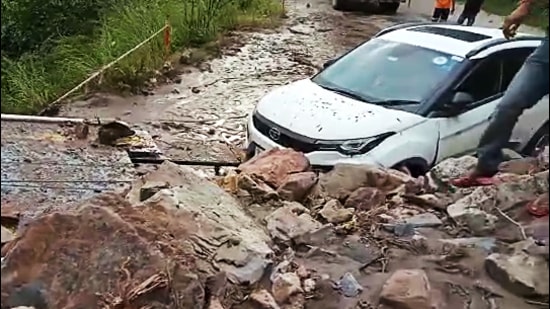Don’t just blame big-ticket projects for the destruction of the Himalayas
There are plenty of other comparatively much smaller, below-the-radar schemes that are chipping away the natural heritage of these ecologically fragile states. Like highways and dams, these too continue, despite protests, in the name of development and taking advantage of State oversight or, in many instances, unethical governance.
This year’s monsoon season has been hard on Uttarakhand and Himachal Pradesh. Both states witnessed intense rainfall in short durations (a tell-tale sign of the climate crisis), flash floods, and landslides. The result: Loss of lives and livelihoods, the ruin of expensive and hard-to-build infrastructure, and long-term ecological damage of the disaster-affected regions, which is sure to have wider ramifications.

It is, however, wrong to blame only the climate crisis for such losses; unrestrained anthropogenic activities in Himalayan regions, as elsewhere, are exacerbating the climate crisis and exposing the residents of these ecologically sensitive and earthquake-prone regions to its brutal impact.
According to a report in this newspaper on August 4, government data shows that there has been a sharp increase in weather-related calamities over the years in the state. Uttarakhand has registered 7,750 extreme rainfall events and cloud bursts since 2015, most of them over the last three years, which have killed 230 people.
Scientists and environmentalists blame, rightly so, big-ticket construction projects in these two states such as the Char Dham Highway Project (Uttarakhand), cascading hydropower projects in both Uttarakhand and Himachal Pradesh (in addition to highways), and unplanned civic and commercial development for destabilising the hill slopes and making them more vulnerable to heavy rainfall events. Yet, despite these scientific warnings, and in many instances, strong local protests and court cases, many of these mega projects continue unabated in the name of development, national security, and water and energy security.
Nevertheless, these big-ticket projects are not the only ones that are destroying the Himalayan region. There are plenty of other comparatively much smaller, below-the-radar schemes that are chipping away the natural heritage of these ecologically fragile states. Like highways and dams, these too continue, despite protests, in the name of development and taking advantage of State oversight or, in many instances, unethical governance.
Authorities often play smoke and mirrors with citizens who demand information about local “development” plans.
Take for example, the Sattal Lake, a set of seven interconnected freshwater lakes in Uttarakhand’s Nainital district. Set among dense forests of oak and pine trees (categorized as reserve forests), the ecologically fragile mesotrophic group of lakes is one of India’s few unspoiled and unpolluted freshwater biomes. The lake area, locals say, has over 525 varieties of butterflies and 500 species of birds. Plus, the lake has different types of fish, including Mahseer. Yet, unlike the other lakes in the district, including the famous Nainital Lake, Sattal still retains its original beauty with very few shops, hotels and houses in the area.
Sattal is a treasure in a climate-hit world. But instead of nurturing the area and its biodiversity, and using it as a bulwark against the climate crisis, the state government has reactivated an old ₹6-7 crore-Lake Side Beautification and Development project plan, which involves building a children’s park, a view point and beautification and landscaping work.
As it often happens, the plan was designed without taking into account the views of the local community, which play an enormous role in saving flora and fauna of the area. This plan has sparked protests because locals believe that concretisation of the area will adversely affect the ecology around the area, and cut off water channels from the catchment areas that feed the lake.
They don’t want Sattal to become another Nainital Lake, Bhimtal and Naukuchiatal, which are over-concretised, polluted, and overrun by tourists. “In the past few decades this beautiful mountainous lake [Naintal Lake] has become endangered, as drastic changes have accrued in its physical, chemical and biological features as a result of man’s accelerated and unthoughtful activities in the catchment areas,” says a 2020 study by Sudhir K Srivastava of the Central Ground Water Board.
The Sattal case is not the only one that shows disinterest in sustainable planning and governance. The same attitude crops up again in another part of the Nainital district where residents of half a dozen villages are protesting against misuse of borewells, which extract water from aquifers, for residential and commercial construction. The realty sector is booming due to the in-migration of people from the plains, at a time when Himalayan springs, which are a critical water source, are drying because of deforestation and the climate crisis.
Himachal Pradesh, too, is facing similar challenges. In 2018, Shimla went without water for eight days. This state faced a water crisis this year too. In the coming years, experts say, Himalayan towns will face a severe water crisis due to changes in precipitation patterns, land use, and (where relevant) impacts due to changes in the snowmelt and glaciation processes in the higher altitude.
To save the Himalayan regions, the country needs a pan-Himalayan development strategy based on each state’s natural resources, culture, and traditional knowledge, and political and administrative will implement that strategy. Unfortunately, state governments seem to be only keen on extracting a green bonus from the centre for their “conservation efforts”. Mountains matter, and it’s time we start paying attention to them.
The views expressed are personal
Continue reading with HT Premium Subscription





